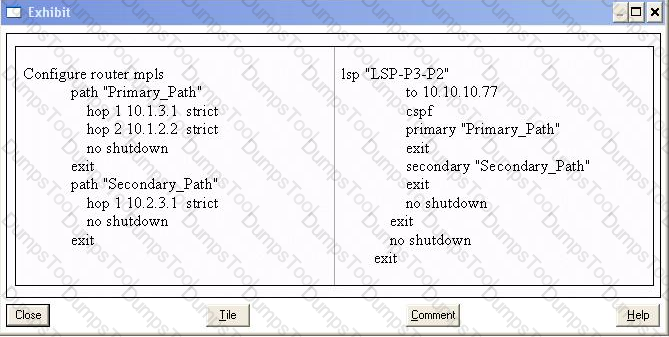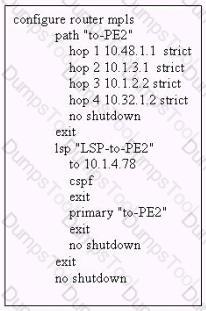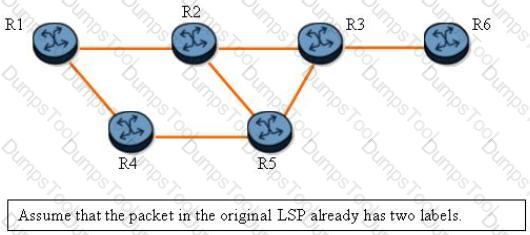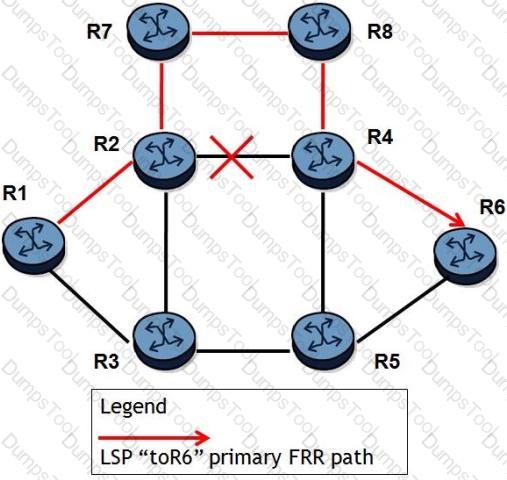Click on the exhibit.

Under which condition might the peer entry with an LDP ID of 10.10.10.2:0 show the state "Nonexistent"?
Which of the following can be used for label signaling and distribution on the Alcatel-Lucent 7750 SR? Choose two answers
Which of the following LDP messages are used in the successful establishment of LDP sessions? Choose three answers
Which of the following describes how a router sets the destination IP address for an RSVP RESV message?
Which of the following statements regarding per-platform label space are true? Choose two answers.
An LSP path is configured as follows:
- Shared-explicit reservation style
- Make-before-break (MBB) enabled
- 500Mpbs bandwidth reserved on a 1Gbps link
With 100Mbps of unreserved bandwidth remaining, the operator increases the LSP-path's bandwidth reservation to 900Mbps. What happens to the existing LSP?
Which of the following indicates the path over which an LSP's tail end router will return an RSVP RESV message?
Which of the following about Fast Reroute link protection tunnels is FALSE?
A targeted-LDP session may exist between directly connected or non-directly connected devices
If an LSP's loose primary path includes the statement "include green" and "exclude red;" how does CSPF choose the LSP's path?
Which of the following reservation styles can be used to prevent both the primary and secondary paths from booking resources on a common link?
Click on the exhibit button below.

Given the configuration below, which of the following scenarios is FALSE?
Which of the following statements regarding RSVP path messages on an Alcatel-Lucent SR is true?
Which of the following statements regarding LDP-over-RSVP are true? (Choose two)
Which of the following statements regarding RSVP refresh reduction are true1? (Choose two)
Click on the exhibit button below.

Given the configuration below, what is the system ID of the destination node?
Which of the following about an LSP protected with one-to-one FRR is TRUE?
Click on the exhibit.

An LSP traverses R1-R2-R3-R6 and one-to-one fast reroute is enabled. If the protected LSP transports two labels, and router R2 has failed, how many labels will be on the detour path?
Which of the following about RSVP refresh reduction on a Alcatel-Lucent 7750 SR is FALSE?
Which of the following about RSVP-TE LSP configuration in a Alcatel-Lucent 7750 SR is TRUE?
Click on the exhibit.

A fully loose LSP "toR6" is enabled with FRR protection. All links have the same cost. After the link between R2 and R4 goes down, FRR protection repairs the LSP and traffic traverses on R1-R2-R7-R8-R4-R6. Which of the following about this CSPF-enabled LSP on an Alcatel-Lucent 7750 SR is TRUE?
Which of the following modes are used by RSVP-TE on an Alcatel-Lucent 7750 SR?
Which of the following about IS-IS Traffic Engineering on an Alcatel-Lucent 7750 SR is FALSE?
How does a DMP inform the downstream routers that it has merged detour tunnels?
Which of the following devices inspects the MPLS header in the received packet, and exchanges it for a new MPLS header?
Which mode does the following statement describe? An LSR will advertise a label mapping immediately, without waiting for a label mapping from the FEC's next-hop.